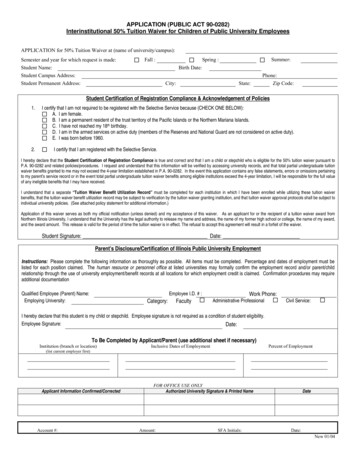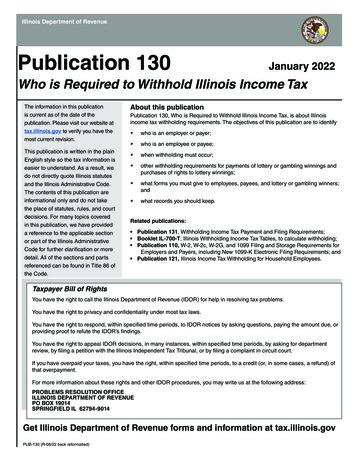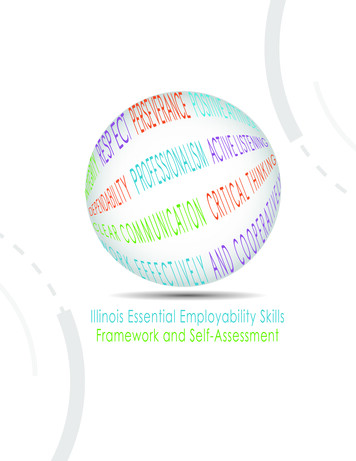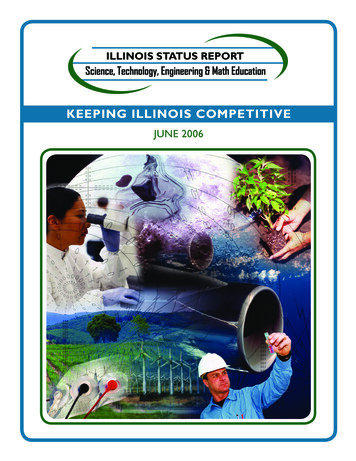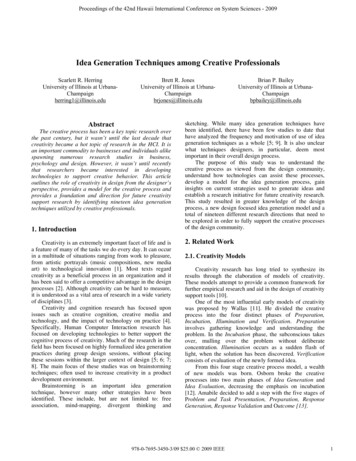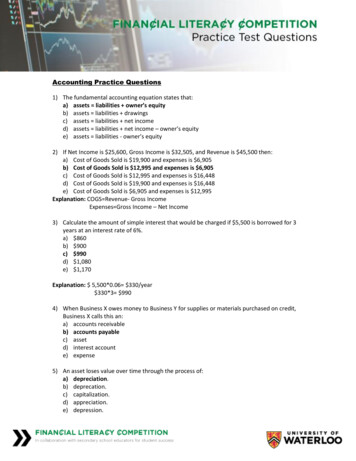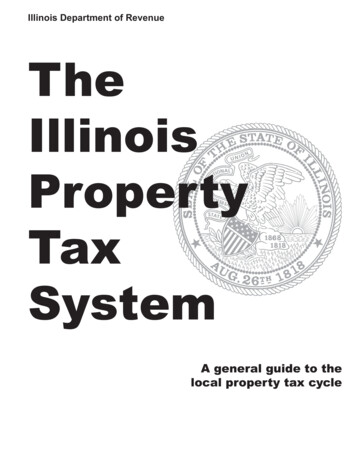
Transcription
Illinois Department of RevenueTheIllinoisPropertyTaxSystemA general guide to thelocal property tax cycle
Illinois Department of Revenue property tax administration responsibilitiesThe Department administers the following aspects of the property tax system: Provides technical assistance and training to local officialsMaintains taxing district mapsApproves non-homestead exemptionsEqualizes assessments among countiesAdministers personal property replacement taxesAssesses railroad operating property and pollution control facilitiesPublishes assessment information and appraisal and assessment manualsCertifies annual farmland values to countiesAwards performance bonuses and stipends to assessment officialsFor more information about property taxesVisit:tax.illinois.gov - The Illinois Department of Revenue websitewww.ilga.gov - The Illinois General Assembly websitewww.ptab.illinois.gov - The Illinois Property Tax Appeal BoardWrite:PROPERTY TAX DIVISIONILLINOIS DEPARTMENT OF REVENUEPO BOX 19033SPRINGFIELD, ILLINOIS 62794-9033Call:217 785-1356Property Tax Code Statutes:35 ILCS 200/1-1 et seq.Printed by authority of the State of Illinois - website onlyPTAX-1004 (R-09/18)Page 2The Illinois Property Tax System
Table of ContentsIntroduction 5Property tax defined.5Property taxed in Illinois.5Most people and businesses pay property tax.6Where the taxes go.6The property tax cycle.6Non-farmland property assessment administration cycle.7Budget, levy, tax extension, and collection cycle.8Farmland Assessment Process.9Step 1, Assessment 10The assessor’s title and qualifications.10Properties assessed by the State of Illinois.10Market value.10Non-farm property assessment process. 11Farmland assessment process. 11Reassessments.12Assessment change notices.13Reasons property assessments may increase.13Step 2, Review 13Board of review composition.13Board of review powers and duties.14Assess omitted property.14Homestead exemption decisions and non-homestead exemption recommendations.14Ensure equitable assessments.14Review complaints.14Before filing a written complaint.14Filing a written complaint with the board of review.15Possible grounds for property tax appeals.15Filing an appeal with the Property Tax Appeal Board, or filing a tax objection in circuit court.16Filing an appeal with the Property Tax Appeal Board.16Filing a tax objection with the circuit court.16Step 3, Equalization 17Assessment levels must be uniform.17How uniformity is achieved.17How the state equalization factor affects assessments.18Assessment variation among counties.18Step 4, Levy 19How a taxing district develops its budget.19Truth-in-Taxation Law - Levy.19The Illinois Property Tax SystemPage 3
Table of contentsStep 5, Extension 20When the county clerk extends taxes.20Calculating the tax rate.20The tax base’s effect on the tax rate.20Tax rates may be limited.20The Property Tax Extension Limitation Law (PTELL).21The PTELL’s effect on individual tax bills.21Calculating the tax bill.22Why tax bills increase.22Step 6, Collection and Distribution 23Tax bill information requirements.23Tax objection complaints.24The tax distribution process.24Enforcement actions for delinquent taxes.24Tax sales.25Annual tax sale .25Sale of forfeited taxes and scavenger sales.25When to redeem properties sold for delinquent taxes.25How much must be paid to redeem the property.25Tax deed proceeding.25Property Tax Exemptions and Incentive and Relief Programs 26Non-homestead exemptions.26Homestead exemptions.26Preferential assessments.28Incentives.30Other types of property tax relief.31Glossary 32Page 4The Illinois Property Tax System
IntroductionProperty tax is the largest single tax in Illinois, and is a major source of tax revenue for localgovernment taxing districts. Every person and business in Illinois is affected by property taxes —whether by paying the tax or receiving services or benefits that are paid for by property taxes. Owners of real property (like a house, land, commercial or industrial buildings) pay propertytaxes directly. People who do not own real property most likely pay the tax indirectly,perhaps in the form of rent to a landlord. Anyone who attends public school, drives on roads or streets, uses the local library, haspolice protection, has fire protection services, or benefits from county services, receivesservices paid for, at least in part, by property taxes.This document explains, in general terms, the main components of the Illinois property tax systemand the people or agencies responsible for administering those components. This document isnot a definitive interpretation of property tax law. (Local assessment officials are the resource forspecific factual information about property taxes.) The applicable Illinois laws can be reviewed inthe Illinois Property Tax Code (35 ILCS 200/1-1 et seq.) at www.ilga.gov.Property tax definedProperty tax is a tax that is based on a property’s value. It is sometimes called an “ad valorem”tax, which means “according to value.”Property tax is a local tax imposed by local government taxing districts (e.g., school districts,municipalities, counties) and administered by local officials (e.g., township assessors, chiefcounty assessment officers, local boards of review, county collectors). Property taxes arecollected and spent at the local level.Illinois does not have a state property tax. When Illinois became a state in 1818, the IllinoisConstitution allowed the state and local taxing districts to tax property in direct proportion to itsvalue. The last year the State of Illinois imposed real estate taxes was 1932. Since then, propertytaxes have only been imposed by local government taxing districts.Property taxed in IllinoisProperty can be divided into two classes — real and personal. Real property is land and any permanent improvements. Examples include buildings,fences, landscaping, driveways, sewers, or drains. Personal property is all property that is not real property. Personal property includes suchitems as automobiles, livestock, money, and furniture.Only real property is taxed in Illinois. The 1970 Illinois Constitution directed the legislature toabolish personal property taxes and replace the revenue lost by local government taxing districts,including school districts. Corporations, partnerships, limited partnerships, joint ventures, andsimilar entities continued to pay taxes on personal property until 1979. These business entitiesnow pay a replacement tax on income and invested capital to the state. These monies are thendistributed to the local government taxing districts in proportion to the amount received from thepersonal property tax for the 1977 tax year (1976 for Cook County).The Illinois Property Tax SystemPage 5
IntroductionMost people and businesses pay property taxGenerally, everyone pays property taxes. Homeowners and owners of commercial, industrial, and agricultural property pay propertytax directly. Renters contribute to the property tax, but generally do so indirectly through their rent.Landlords consider taxes a cost of doing business and adjust their rents to cover them. Leaseholders pay property taxes on real property leased from an owner whose property isexempt (e.g., the state owns agricultural property and leases it to a farmer).Illinois statutes do provide some exemptions from property tax for certain kinds of real property.(See Property Tax Exemptions and Incentive and Relief Programs.)Where the taxes goProperty tax is a major source of tax revenue for the more than 6,000 taxing districts in Illinois;therefore, it funds most of the services local governments provide. Some types of governmentalunits, such as home rule units of government, have additional taxing powers so they are lessdependent on property tax than units that do not have these additional taxing powers. Othersources of revenue include state aid or federal funding.The largest share of the property tax dollar goes to school districts.The property tax cycleGenerally, the property tax cycle is a two-year cycle. During the first year, property is assigned avalue that reflects its value as of January 1 of that year. (For farm acreage and farm buildings,a certification and review procedure is initiated more than nine months before the assessmentprocess begins.) During the second year, the tax bills are calculated and mailed and payments aredistributed to local taxing districts.This two-year cycle can be divided into six steps.1 Assessment — All property is discovered, listed, and appraised so that values for propertytax purposes can be determined. Local assessing officials determine most property values;the local county board of review and the Illinois Department of Revenue also have someassessment responsibilities. The chief county assessment officer ensures that assessmentlevels are uniform and at the legal assessment level by applying a uniform percentageincrease or decrease to all assessments in the jurisdiction (i.e., assessments are “equalized”).2 Review of assessment decisions — County boards of review determine whether localassessing officials have calculated assessed values correctly, equalize assessments withinthe county, assess any property that was omitted, decide if homestead exemptions shouldbe granted, and review non-homestead exemption applications. Property owners and localtaxing districts may appeal unfair assessments to their local county boards of review and, ifthe owner is dissatisfied with the board’s decision, the State Property Tax Appeal Board orcircuit court.3 State equalization — The Illinois Department of Revenue equalizes assessments amongcounties and issues a state equalization factor for each county.4 Levy — Taxing districts determine the amount of revenues that they need to raise from propertytaxes, hold any required public Truth-in-Taxation hearings, and certify levies to the county clerk.5 Extension — The county clerk applies the state equalization factor, calculates the tax rateneeded to produce the amount of revenues each taxing district may levy legally, apportionsthe levy among the properties in a taxing district according to their equalized assessedvalues so that tax bills can be computed, abates taxes as directed by taxing districts, andprepares books for the county collector.6 Collection and distribution — The county collector prepares tax bills, receives property taxpayments from property owners, distributes taxes to the local government taxing districts thatlevied them, and administers sales of liens on real estate parcels due to nonpayment of taxes.Page 6The Illinois Property Tax System
IntroductionNon-farmland Property Assessment Administration CycleCounty ClerkChief CountyAssessmentOfficer (CCAO)TownshipAssessorChief CountyAssessmentOfficer (CCAO)IllinoisDepartment ofRevenueBoard ofReviewCounty ClerkIllinoisDepartment ofRevenueCounty ClerkIllinoisDepartment ofRevenuePrepares two sets of real estate assessment books and delivers them to the chief countyassessment officer (CCAO) by January 1.1 Meets with township assessors before January 1 and establishes guidelines.2 Delivers one set of books to township assessors.Values real estate as of January 1 and returns books to the chief county assessment officer by1 June 15 for counties with less than 600,000 inhabitants,2 July 15 for counties with 600,000 or more but no more than 700,000 inhabitants, or3 November 15 for counties with more than 700,000 but less than 3,000,000 inhabitants.1 Reviews assessments made by township assessors and makes changes when deemednecessary.2 Equalizes assessments within county by class and/or by township (except for Cook County).3 Mails change of assessment notices to taxpayers.4 Publishes changes in newspaper of general circulation.5 Delivers books to board of review by the third Monday in June or on or before 90 days after thebooks are returned.6 Prepares tentative abstract of assessment books and mails the abstract to the IllinoisDepartment of Revenue.1 Develops tentative equalization factor.2 Publishes factor in newspaper.3 Holds public hearing.1 Assesses omitted property.2 Acts on all homestead exemptions and mails recommendations about non-homesteadexemptions to the Department for approval.3 Hears complaints and makes changes on any property when deemed necessary.4 Mails change of assessment notices to taxpayers.5 Equalizes assessments within county if necessary (except for Cook County).6 Delivers books to county clerk.7 Mails report on equalization to the Department.8 Makes a list of changes and gives the list to the CCAO and county clerk.Prepares the final abstract of assessments and mails it to the Illinois Department of Revenue.Certifies the final equalization factor to the county clerk and publishes the factor.Applies equalization factor to all local assessments (except farmland, farm buildings, and coalrights).Certifies state assessments and mails them to the county clerk.The Illinois Property Tax SystemPage 7
IntroductionBudget, Levy, Tax Extension, and Collection CycleCounty ClerkTaxing BodyCounty ClerkCountyTreasurer(serves as thecounty collector)Circuit CourtCounty Clerkand TreasurerTotals the equalized assessed value for each taxing district.1 Prepares tentative budget. (Dates differ based on type of taxing district.)2 Publishes notice of public hearing; puts tentative budget on public display 30 days beforepublic hearing.3 Holds public hearing.4 Passes budget with changes in form of ordinances.5 Publishes levy and holds public hearing.6 Publishes Truth-in-Taxation publication and, if required, holds public hearing.7 Gives certificate of levy to county clerk by the last Tuesday in December.1 Calculates tax rates for each combination of taxing districts.2 Extends taxes on equalized assessed value and enters in collector’s books.3 Delivers collector’s books to county treasurer by December 31.12345Pronounces judgment for sale of a lien on real estate due to nonpayment of taxes and rules ontax objections.Administers sale of lien on real estate due to nonpayment of taxes.*Page 8Prepares and mails tax bills by May 1.*Collects first installments for real estate by June 1.*Distributes tax money proportionately to taxing districts as tax money is collected.Collects second installment for real estate by September 1.*Prepares delinquent tax list and sends notice of application for judgment and sale of a lien onreal estate due to non-payment of taxes.For counties using accelerated billing, estimated bill is mailed by January 31; first installment due by March 1 (or dateprovided in county ordinance or resolution); final bill mailed June 30; last installment normally due by August 1. Counties may also provide a four-payment schedule.The Illinois Property Tax System
IntroductionFarmland Assessment ProcessState Farmland Technical Advisory Board provides income, productivity, and yield data.Department of Revenue (DOR) compiles data and calculates agricultural economic value for each soil productivity index.DOR certifies farmland assessment values by productivity index rating to chief county assessment officer by May 1.Chief county assessment officer presents values to County Farmland Assessment Review Committee by June 1.Public hearing is held.County FarmlandAssessment ReviewCommittee accepts statevalues and procedures.Illinois Department of Revenue ruling by September 1.Local assessors implementbeginning January 1 byassessing farm parcels.County Farmland AssessmentReview Committeerejects state values and/or procedures. Developsalternatives, presents to DORby August 1.DOR reviews CountyFarmland AssessmentReview Committeealternatives.Property Tax Appeal Board ruling by December 31.County FarmlandAssessment ReviewCommittee has until October1 to appeal DOR ruling toProperty Tax Appeal Board.The farmland assessment applies to tracts of property that have met the legal definition of a “farm” for the previoustwo years. Farmland is assessed according to its agricultural economic value (and other statutory provisions).Agricultural economic value, commonly called use-value, is based on statewide studies of land use under average levelmanagement, soil productivity, and of the net income of farms in Illinois.The Illinois Property Tax SystemPage 9
Step 1: AssessmentStep 1AssessmentAn assessment is the property value that officially is entered in the county assessment books(sometimes called the “tax rolls”). This value is used to determine what portion of the total taxburden each property owner will bear. This section describes the assessor’s role in the first stepof the property tax cycle.The assessor’s title and qualificationsCounty assessment officials on a statewide basis are collectively called chief countyassessment officers (CCAO). The actual title of the person who completes the propertyassessment depends on the county’s form of government. In Cook and St. Clair counties, the county assessor has primary assessment responsibility. In the 17 commission counties1, which have no township level government, the supervisor ofassessments has primary assessment responsibility. In the other 83 counties, township or multi-township assessors have primary assessmentresponsibility. There are more than 900 of these elected assessors, most of whom servepart-time only.The chief county assessment officer supervises and, if necessary, revises township and multitownship assessors’ work.Chief county assessment officers are usually appointed by county boards and must have twoyears of relevant experience, pass a qualifying examination, and possess certain professionaldesignations for completing courses in assessment techniques successfully.Note: In some counties, the chief county assessment officer is elected.Properties assessed by the State of IllinoisThe Illinois Department of Revenue assesses the following types of property: Railroad operating propertyPollution control facilitiesLow sulfur dioxide emission coal fueled devicesRegional water treatment facilitiesThe Illinois Department of Revenue assesses these properties and certifies values to the countyclerks, who include the assessments in the local tax bases. The value of state-assessed propertyis a small percentage of the value of all taxable property.Market valueValue is a complicated concept with many definitions. Most real property in Illinois must be assessedbased on its value on the open market, or its “market value.” This value is the amount at which aproperty would sell in a competitive and open market, presuming that both the buyer and seller are knowledgeable about the sale and are using sound judgmentby allowing sufficient time for the sale, and the sale is not affected by undue pressures (e.g., foreclosure, bankruptcy).1Alexander, Calhoun, Edwards, Hardin, Johnson, Massac, Menard, Monroe, Morgan, Perry, Pope, Pulaski, Randolph, Scott, Union, Wabash, andWilliamsonPage 10The Illinois Property Tax System
Step 1: AssessmentOne or more of the following three methods is used to determine market value: Market data — Similar, neighboring properties that have sold recently are compared to theproperty being assessed. Cost — The cost to reproduce (or rebuild) the property is calculated, an amount for depreciation(e.g., wear and tear, age) is subtracted, and land value is then added. Income — The present worth of the income from an income-producing property iscalculated by measuring the amount, quality, and durability of the future net income theproperty can be expected to return to an investor.By law, most real property is assessed at 331/3 percent of market value. There are someexceptions to this rule, however. Farm acreage is assessed based on its ability to produce income, which is called itsagricultural economic value. A farm building is assessed at one-third of the value that itcontributes to the farm’s productivity. (Farm home sites and farm dwellings are assessed atone-third of their market value.) Counties that have a population of more than 200,000 may classify property for assessmentpurposes. Cook County is the only county that has adopted such a system; it has 13 classesof property. The county ordinance specifies assessment levels from 10 percent of market value(residential property) to 25 percent of market value (commercial property). Developed coal is assessed at 331/3 percent of its coal reserve economic value. Illinois statutes provide alternate valuation procedures or exemptions for certain qualifyingproperties. (See “Property Tax Exemptions and Incentive and Relief Programs.”)Non-farm property assessment processThe county clerk prepares real estate assessment books and delivers them to the chief countyassessment officer by January 1, the date that the assessment cycle for all real property (exceptfarmland) begins. These books list all real estate parcels that must be assessed. The chief countyassessment officer may correct the books if any property is not listed or if a property’s description isincorrect. Farmland assessment procedures begin May 1 of the year before the assessment year. In the 17 counties that do not have township governments and in St. Clair County, thesupervisor of assessments completes the assessments by June 1 (other than in generalassessment years). In non-commission counties other than Cook, Lake, and DuPage counties, township andmulti-township assessors complete their assessments, certify that their assessment booksare correct, and return their books to the chief county assessment officer by June 15. In Cook County, the chief county assessment officer must assess all property as soon as heor she reasonably can. Lake county’s township and multi-township assessors complete their assessments by July15. DuPage County’s township and multi-township assessors complete their assessments byNovember 15.The chief county assessment officer reviews the books and makes any changes ne
Page 6 The Illinois Property Tax System Most people and businesses pay property tax Generally, everyone pays property taxes. Homeowners and owners of commercial, industrial, and agricultural property pay property tax directly. Renters contribute to the property tax, but generally do so indirectly through their rent. Landlords consider taxes a cost of doing business and adjust their .



